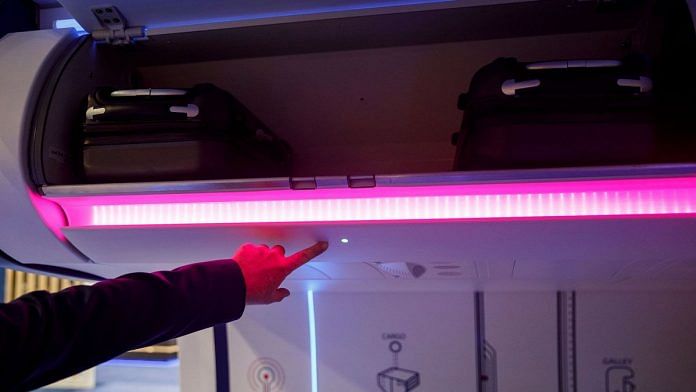Dallas: Attention airline bathroom loiterers: The next generation of Airbus aircraft will track how long you’ve been in there.
It’s all part of an effort to make commercial cabins a digitally aware domain. The program is Airbus’s bid to raise the Internet of Things—that buzz-phrase for connected household gadgets—to cruising altitude.
The Airbus Connected Experience aims to give flight attendants a more detailed survey of the cabin, with sensors for such critical data as when bathroom soap is running low and how much toilet paper remains in each bathroom. But the rethinking of the passenger environment doesn’t just stop with the lavatory.
At each seat, your belt will signal red for unbuckled and green when fastened. The goal is faster boarding and departure, dispensing with those lap-scrutinizing walk-throughs flight attendants must perform. The crew will also have access to information on what’s onboard and where, like which galley carts contain specific meals, such as preorders or vegetarian selections.
“It’s not a concept, it’s not a dream: It’s reality,” Ingo Wuggetzer, Airbus’s vice president of cabin marketing, said Tuesday at an aviation trade show in Los Angeles. Airbus has begun flight testing the connected cabin on its A350 test aircraft and plans to introduce it on the A321 family in 2021, followed by the larger, two-aisle A350 series two years later.
As cool as all of this may seem to you, the passenger, it’s just another way for airlines to squeeze more profit out of operations. While data from these various areas will be sent to flight attendant tablets or smart phones in real time, the crunching of that data over time is where the real value lies. The connectivity Airbus envisions for its cabins will provide an enormous trove of information airlines can use to analyze and optimize in their never-ending quest for cost efficiencies.
From the time it takes a flight attendant to respond to a call button, to preferences for prosecco versus chardonnay, to which bathroom gets the most use—the information can help optimize all aspects of flight. “You can make the service more attentive,” said Ronald Sweers, an Airbus cabin-products director. While the digital doodads are expected to simplify flight attendant workloads, their true value may lie in giving airlines more insights about what happens in the cabin.
That space, Wuggetzer noted, is a virtual “black box” to carriers once the plane leaves a gate. But not for much longer.
Airbus also plans to offer airlines the option of cameras at each lavatory (on the outside, mind you) to count how many passengers are waiting, a feature which may help flight attendants redirect some of that traffic on larger jets. While certainly helpful to that man in 17C who had one too many sodas, the data will also show airlines the length of wait times on various flights, and on different aircraft types.
More seriously, it can also alert a flight attendant that someone inside may be ill or need assistance, Wuggetzer said.
The crew will also be able to control features such as window shades and public address volume from their mobile devices. The system will know which overhead bin spaces are open, with green lights along the cabin, much like the lighting schemes used in parking decks to signal drivers toward unoccupied spaces. That should, in theory, speed boarding, Airbus says.
As far as Airbus is concerned, the cabin’s platform is open so customer airlines can attach their own crew applications or other software, Sweers said. Many large carriers have customized or proprietary software for such onboard tasks as catering.
“The feedback we heard from airlines was, ‘OK, Airbus, we don’t believe you’re able to give us an application that will work with our systems,’” Sweers said on the trade show floor, discussing the galley equipment. – Bloomberg
Also read: The electric cars are here. Now how about selling them






